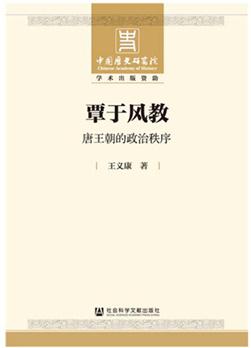
. > WHAT'S NEW > BOOKS
Tang border governance seen from politics of law
Author : SONG PEIJUN Source : Chinese Social Sciences Today 2021-04-12

Tang-Dynasty Political Order
Tang-Dynasty Political Order, authored by Wang Yikang, a research fellow from the Institute of Chinese Borderland Studies at the Chinese Academy of Social Sciences (CASS), paints the historic picture of Chinese territories and people in the Tang Dynasty (618–907) through the lens of the politics of law.
The Hua-Yi distinction is an ancient Chinese conception that differentiated a culturally defined “China” (called Hua, Huaxia, or Xia) from cultural or ethnic outsiders (Yi “barbarians”). Correspondingly, the Hua-Yi relationship discussed in the book lies in the political relations established between Tang China and Yi, which belongs to the Hua-Yi order’s research field.
Most domestic studies of the Hua-Yi relationship in the Tang Dynasty trace ethnic development and borderland formation from the perspective of ethnic relations or ethnic history, while international scholars are mainly interested in East Asian order in the Tang Dynasty from the perspective of world history or international relations. This book makes an explorative attempt to probe the nature of Hua-Yi political relationships, and the fundamental principles and evolution of the Hua-Yi order, or the order of Tianxia (all under heaven), centered around Tang.
The Tang court formulated a relatively complete system of policies regarding borderland governance. For example, in terms of handling Yi’s foreign affairs (diplomatic power), in 701, under the reign of Empress Wu Zetian, it was stipulated that lower administrative regions must report to the court upon taking in and greeting foreigners, showing exclusive imperial rights to communicate with foreign countries. For foreigners coming to Tang territories, Shangshu Sheng (the Department of State Affairs) was responsible for checking entry-exit personnel, while ordering frontier officials to re-check the number of foreigners entering.
Moreover, when discussing the power to assign officials, the court can appoint officials, confer titles of nobility and award decorations in border areas. Han-ethnic officials were also dispatched in Jimi Prefectures (remote ethnic minority areas where self-governance was allowed) in addition to their own ethnic hereditary officials.
The Tang court endowed borderland areas with tax exemptions for either two, three, or ten years, according to specific modes of entry into the Dynasty, namely whether surrender was forced or voluntary. In addition, regarding Tang’s power of conscription, Dudu Fu (the commanders-in-chief’s bureau or the jurisdiction) were set up in royal capitals from the west of Khotan to the east of Persia, and Zhechong Fu, or primary-level military offices, were established in these regions’ lower administrative divisions. Records relating to Tang’s conscription from Persian Dudu Fu were found in literature from the Dunhuang Grottoes.
Song Peijun is from the Institute of Borderland Studies at CASS.
Ye Shengtao made Chinese fairy tales from a wilderness
Ye Shengtao (1894–1988) created the first collection of fairy tales in the history of Chinese children’s literature...
-
How northern ethnicities integrated into Chinese nation
2023-09-18
-
Mogao caves
2023-09-12
-
Mogao Grottoes as ‘a place of pilgrimage’
2023-09-12
-
Time-honored architectural traditions in China
2023-08-29
-
Disentangling the civilizational evolution of China
2023-08-28
-
AI ethics in science fiction
2023-08-23













 2011-2013 by www.cssn.cn. All Rights Reserved
2011-2013 by www.cssn.cn. All Rights Reserved